Tuesday, I killed more time in Pula. I got coffee at a cafe frequented by James Joyce when he lived in Pula in the early 1900s.
One thing I noticed is that poverty is much more visible in Croatia than it was in Slovenia. Whereas in Slovenia, I don’t think I saw one homeless beggar in my whole time there, I saw them regularly in Pula. Much of the population of Pula seems to be elderly pensioners just barely scraping by. I was talking to a couple of young Croatians at a coffee bar/internet cafe, and they felt the difference was the effect of war.
“You know, the war barely touched Slovenia, but there was war here in Croatia only 5 or 10 years ago. You can still feel it in the air,” suggested one girl
“Not in the air. In the people. You see it in the people,” corrected her friend.
Other people I talked to felt that the fault lay with the Croatian economy. After explaining the grant I’m traveling on, one guy I was talking to reflected, “You see, that’s the great thing about America. Somebody can get money just to study something. Here in Croatia, there’s no money for anything. The government blames the problems on the worldwide economic crisis, but it’s just an excuse. The economic crisis in Croatia began ten years ago.”
Whatever the causes, conspicuous poverty is a tough thing for me to deal with. My natural inclination is always to give money to beggars, especially if it’s the amount I’d piss away on a cappuccino later anyway. I know that it’s ultimately sort of futile. There will always be more beggars, and I have no way of telling who really needs it and who doesn’t, who’s going to buy food and who’s going to buy booze, but it’s still hard for me to say ‘no’.
I’ve decided I’m going to do some research and give a lump-sum donation to reputable charity that helps the homeless. I hope the Watson Foundation will consider allaying my liberal guilt a worthy use of some small fraction of their money. It’s either that, or little amounts given away in dribs and drabs where it won’t do any good.
Wednesday evening, I returned to the Rojc building to meet with Edgar. He surprised me by being older than I’d expected. I’d sort of assumed he’d be the same age or slightly older than the infoshop kids (late teens/early 20s), but he seemed to be in his late20s/early 30s. He said he and his friends had started the hacklab around 2001, after returning home from university in Zagreb. It was designed to be a place to educate people about technology and free software and cater to the political activist set. In 2004 they held a pretty large Transhack meeting there. He said Richard Stalman had come to visit (for non-geeks: this is sort of like John Lennon coming to hear your garage band). John Zerzan, had also paid a visit, although why an anarcho-primitivist would want to visit a hacklab is beyond me.
However, over time, it became clear that the hacklab wasn’t serving its intended purpose. Most of the visitors were teenagers from the juvenile delinquent house down the road, who were fond of stealing the cheap mice for no reason beyond wanting to steal things. Edgar said theonly other users were Roma or the very poor. Providing access to technology for undeserved groups is a worthy goal of its own, but it wasn’t the original goal of the hacklab, and Edgar said he was tired of feeling like he was babysitting delinquent teens and trying to explain to them that stealing from a community hacklab was only screwing themselves over.
Edgar said he felt like Pula probably just isn’t a big enough town to support the hacklab. There aren’t enough hackers or enough activists around to justify it. Like many other people I’ve talked to, he noted the widespread availablity of cheap, highspeed ADSL as a factor in the death of the hacklab. He told me that MaMa in Zagreb is doing much better, but he thought they had sold out a little bit by being non-ideological and setting up a commercial web cafe to finance the hacker/cultural stuff.
On Thursday, I talked to Ivica, another one of the founding members of the Pula hacklab. Another contact who knows both Edgar and Ivica told me that Edgar “will tell you the dark side” and Ivica “will tell you the bright side,” and indeed, Ivica did seem to have a much more positive take on the status of the hacklab.He told me that he didn’t feel like it was an ex-hacklab so much as a hibernating hacklab. He noted that as an infoshop, the hacklab was still providing technology access to activists and artists, alibeit in a more closed way than originally intended. He also emphasized that the hacklab people still did hardware recycling, fixing up old computers and giving them away for free, and still ran webservers for many of the groups based at the Rojc building.
He did concede that perhaps the hacker scene was too small in Pula. He told me that there were 15 or 20 people on the hacklab’s internal mailing list, but that only about 4 or 5 of them were the kind of people who could easily install and configure a Linux system without assistance. He echoed Edgar’s frustration with “yelling at kids for looking at too much porn”.
He also gave me a little bit of background on the origins of the Monteparadiso collective. Apparently it started at another Austrian fort on top of Monteparadiso Hill (almost every place in Pula has both an Italian and a Croatian name; there are 7 hills in Pula [just like Rome], which is why the Romans built an amphitheater there). It’s in a residential neighborhood, and the area teens used to hang out there. Eventually they bought gates and locks and installed them to keep out drug addicts. Ivica told me a funny story about how one day the cops came by the fort and were like, “What are you doing?” and one of the kids told him, “Oh, it’s ok, we have the keys,” and the cops accepted that and went away.
They started organizing their own DIY punk shows and festivals, which became a pretty big deal. Eventually they outgrew the Monteparadiso fort, and moved their collective to the Rojc building. The hacklab was the “Monteparadiso Hacklab” because it grew out of this collective. Ivica was kind of wistful about that, saying that “punk got to Pula 20 years late, same with the DIY movement; with the hacklab, we felt like for the first time we were part of a movement at the same time it was happening everywhere else.”
The next day, I went up and saw the old Monteparadiso fort, before catching a bus to Zagreb.

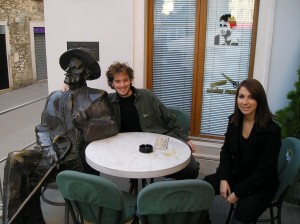
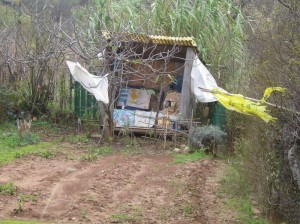
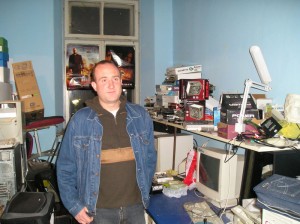
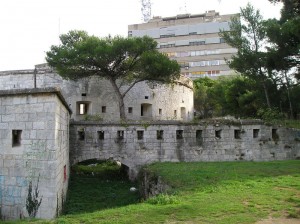
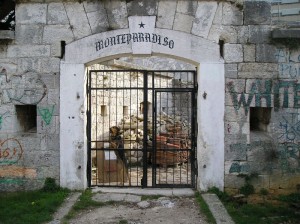
“Oh, it’s OK we have the keys.” Amazing. If only that excuse worked for everything. I also love how the girl in the James Joyce picture looks so weirded out.
~Steve
cool, nice to see that you made it to pula in the end.. :)